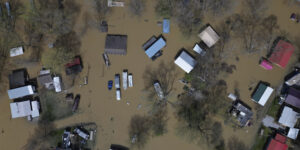American International Group CEO Peter Zaffino said he expects the reinsurance market to remain above losses generated by the frequency and severity of natural catastrophes.
Losses will instead continue to be absorbed by primary insurance companies, he told analysts during an earnings call Tuesday.
“Despite the strong capital position of the market, generally speaking, I would expect the market to remain disciplined at January 1, not reducing attachment points and focusing on deploying capital to the insurance companies with higher quality portfolios like AIG,” he said. “Given that this has become the industry norm, industry losses from increased frequency and severity will continue to be realized by primary insurers and will not be solved by the reinsurance market in 2025.
“How we’re going to price business going forward—how we’re going to understand the frequency of [catastrophes]—is going to be really important to do as an insurance company, and not rely on reinsurance,” Zaffino added.
The “significant reset” of the property catastrophe reinsurance market in 2023 resulted in higher attachment points and named perils for primary insurance while reinsurers took retrocession insurance. The adjustments will likely provide an underwriting profit on reinsurers’ global catastrophe portfolios, Zaffino explained.
After this market correction, about 90 percent of losses have been retained by primary insurers — a big change from when reinsurers absorbed 50 percent of catastrophe losses from 2017 to 2022, he added.

However, the chief executive said AIG has mitigated the impact of catastrophes by changing its approach to underwriting and reinsurance, including a decision to maintain the lowest net retention among its competitors, for “dramatic improvements to our financial performance and balance sheet.”
In 2012, AIG posted pretax losses of $2 billion from Superstorm Sandy. The amount was nearly 7 percent of the estimated $30 billion market loss for the storm. For that entire year, the insurer booked $2.7 billion in losses—about 4 percent of total market losses, Zaffino shared.
“Today, AIG is forecasted to be within our catastrophe loss expectations for the full year—less than 1 percent market share of the forecasted total industry loss for 2024 of over $125 billion,” Zaffino said.
AIG’s general insurance segment third-quarter underwriting income fell to $437 million, with more than $410 million in catastrophe losses, driven by hurricane Helene and Beryl. (AIG said it expects losses from Hurricane Milton of between $175 million and $275 million, to be reflected in fourth quarter results).
One of the ways AIG is improving results is with generative artificial intelligence. Zaffino said AIG is using GenAI to “produce meaningful gains from reducing manual inputs and driving process efficiencies,” but it can also ingest the insurer’s proprietary data for better accuracy rates in underwriting and prioritization of high-value business within its risk appetite.
“It will allow our underwriters to spend more time quoting and winning business and less time manually collecting data,” Zaffino said.
Photographer: Giorgio Viera/AFP/Getty Images





















 Allstate: How Can You Save on Auto Insurance?
Allstate: How Can You Save on Auto Insurance?  Progressive: Policies Grow Faster Than Workforce
Progressive: Policies Grow Faster Than Workforce  Contractors Insurance Alert: Construction Defect Lawsuits Rising
Contractors Insurance Alert: Construction Defect Lawsuits Rising  $1 Trillion! 2024 P/C Industry Direct Premiums At Record Level
$1 Trillion! 2024 P/C Industry Direct Premiums At Record Level 




